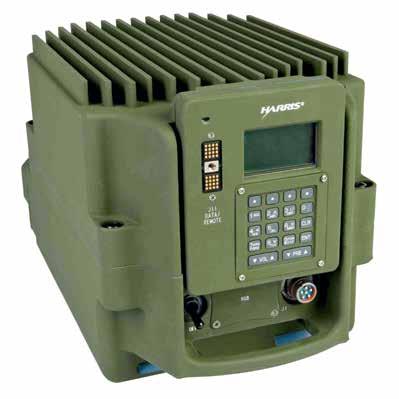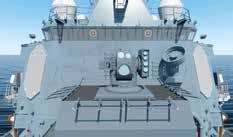Where legacymeets future.
The ideal GRM-122 replacement solution
Standardized radio test for legacy SINCGARS and future waveforms

When it comes to preparation, your fleet comes first. The ATS-3100 RTS helps maximize your operational readiness by ensuring your radios perform when most needed, whether legacy, modern, or a future technology. With powerful, synthetic instrumentation and the ability to maintain your investment in legacy cable sets for SINCGARS radios, the ATS-3100 RTS is the ideal replacement solution for aging and unsupportable radio test systems.
Learn more about our airborne and ground electronic systems maintenance solutions for radio test and wire integrity at astronics.com/defense.




19
TEST SOLUTIONS ELEVATING performance
ATS-6100 WFT CTS-6010
ATS-3100 RTS
PR9560
Power:
Frequencies/waveforms:
Security:
Weight:
Notes:
AT Electronic and Communication International
Power:
Frequencies/waveforms:
Security:
Weight:
Notes:
0.5/2/4W
30MHz to 87.975MHz. Combat Net Radio (CNR), Voice Relay Network (VRN) and Packet Radio Network (PRN) waveforms

AES 256/Customised COMSEC and ECCM
≤ 0.6kg (with 3800mAh battery)
PR9560 is intended for land forces such as infantry, forward observers, snipers, special forces and anti-terrorist units, and can be deployed at the platoon or company level. CNR’s primary role is voice or data transmission in battlefield via point to point/ point to multi-points communication. VRN extends voice communication distance by chaining. PRN mainly serves as data transmission for man to machine and machine to machine in battlefield.

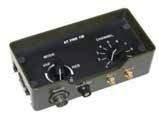
AT Electronic and Communication International
100mW EIRP max
2.4GHz, spread spectrum, 240 operating channels, eight selectable nets

Time hopping, frequency hopping and OFDM resists interception, jamming. 1kg
PRR designed for operation within groups of up to 30 users allows for full duplex communication in ad-hoc digital networks, needs no additional infrastructure. Can link to another network through transceiver connected via USB.
Barrett Communications
Power: Frequencies/waveforms:
Security:
Weight:
Notes:
PRC-2080+
PRC-2081+
30W/10W PEP (Selectable) output power
1.6MHz to 30MHz/ Modes: J3E (USB, LSB), H3E (AM), J2A (CW), J2B (AFSK) modes. Digital Voice: 600/700, 1200, 2400Bps (MELP/TWELP) Encryption standards: AES256 & DES56. Frequency Hopping: 5 or 25 hops per second
3.90kg (5.2kg with Barrett high performance Li-ion Battery with built in charge controller)
2G and 3G ALE options MIL110, 3G (STANAG) & CLOVER data options. PRC-2091 is a 12.85kg tactical mobile transceiver with a vehicle docking station and extra power (125W setting). PRC-2092 is a 14.3kg tactical base station with extra power (125W setting) and a mains power supply.
Barrett Communications
5W hand portable, 25W manpack, 50W mobile, base station & rebroadcast
30MHz to 88MHz, 25kHz channel resolution, 10 channels
Multiple levels of encryption and frequency hopping security available: Analogue VoiceFixed Frequency, Digital Unencrypted Data - Fixed Frequency, Digital Encrypted Voice - Fixed Frequency (DEFF), Digital Encrypted Voice - Frequency Hopping (DEFH), Digital Encrypted Voice
- Free Channel Search (DEFCS), Digital Encrypted Data - Fixed Frequency, Digital Encrypted Data
- Frequency Hopping
1.3kg with battery pack
Military grade portable communication transceiver specifically designed for tactical applications. It is designed to meet complete immersion, vibration, drop to MIL-STD 810G. Available in both handheld and man-pack forms.
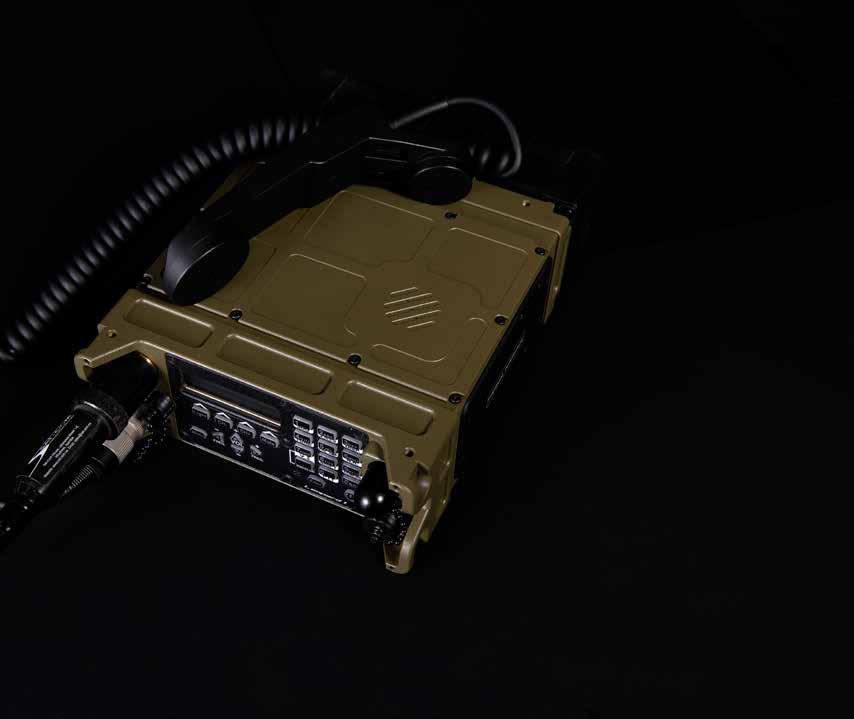



25W
Barrett Communications
30MHz to 88MHz, 25kHz channel resolution,10 channels
Multiple levels of encryption and frequency hopping security available: Analogue Voice - Fixed Frequency, Digital Unencrypted Data - Fixed Frequency, Digital Encrypted Voice - Fixed Frequency (DEFF), Digital Encrypted Voice - Frequency Hopping (DEFH), Digital Encrypted Voice - Free Channel Search (DEFCS), Digital Encrypted Data - Fixed Frequency, Digital Encrypted Data - Frequency Hopping
7.7kg with backpack frame and 16.8V 10 Ah Li-Ion battery pack
PRC-2081+ 25 Watt Man-pack upgrades the PRC-2080+ transceiver with increased power and communication range. Standard package includes: man-pack dock, battery pack, AC/DC charger, collapsible section whip, tape whip antenna, handset, framed backpack.
Barrett
Tx 30W/10W PEP (Selectable), Rx current consumption 250mA
1.6MHz to 30MHz/ Modes: J3E (USB, LSB), H3E (AM), J2A (CW), CF (Custom Filter) ISB (Data) modes. Digital Voice: 600/700, 1200, 2400 Bps (MELP/TWELP)
Encryption Standards: AES256 & DES56. Frequency Hopping: 5 or 25 hops per second
2.95kg (4.55kg with BB2590 Battery / 5.00kg with Barrett high performance Li-ion Battery with built in charge controller)
2G and 3G ALE options, MIL110, 3G (STANAG) & CLOVER data options. Released September 2019. PRC-4091 is a 9.35kg vehicle mobile version with extra power (additional 125W & 150W settings) and a docking station with anti-vibration mounting. PRC-4092 is an 11.15kg base station with extra power (additional 125W & 150W settings) and a docking station and AC mains power supply.
20 2022 Tactical Radios Supplement TACTICAL
RADIOS LISTINGS
PRR 1M
PRC-2090 HF manpack transceiver
Frequencies/waveforms: Security: Weight: Notes: Power: Frequencies/waveforms: Security: Weight:
Power:
Security: Weight:
Power:
Notes:
Frequencies/waveforms:
Notes:
Tactical VHF radio
PRC-4090 HF Tactical Manpack Transceiver
Communications
– 25 W VHF Manpack






2022 Tactical Radios Supplement 21
RADIOS LISTINGS
BLD100 Tactical Radio Benelec


Power: Frequencies/waveforms:
Security:
Weight:
Notes:
1W to 3W
VHF 30MHz to 88MHz, full civilian CTSS squelch, standard military 150Hz sub-audio tone
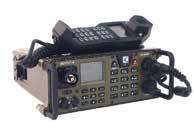
external encryption modules
0.295kg including battery & antenna
Designed for platoon communications, BLD100 is a fixed frequency handheld radio family in IP67 housing, complies with Mil Std 810C, D, E & F. Features built-in data modem.
BL350U UHF FM tactical radio Benelec



Power: Frequencies/waveforms:
Security:
Weight:
Notes:
2W to 4W selectable
380MHz to 420 MHz, up to 128 channels with 12.5Hz or 25Hz spacing
AES 256bit encryption optional
0.285kg including 1700mAH Li-ion battery
Up to 14 hour battery life, IP54 water & dust protection, priority channel & talkback scanning, 1,200/2,400 baud modem, programming via USB, voice operated transmission (VOX).
Tough SDR Handheld Bittium
Power:
Frequencies/waveforms:
Security:
Weight: Notes:
5W (PEP)
30MHz to 2500MHz/ Bittium Narrowband Waveform, Bittium TAC WIN Waveform with data throughput up to 25Mbps, ESSOR High Data Rate Waveform, supports porting of legacy and national waveforms
Red/black separation, secured boot, tampering detection & response, emergency erase, COMSEC and TRANSEC allowing implementation of national algorithms, Application Sandbox for customer applications
950g with battery
SDR-based tactical handheld radio for individual soldiers, such as squad or platoon leader, providing a uniquely wide frequency range. With flexible configuration options and routing networks, supporting ‘thousands’ of radios in one network. Built-in GNSS, camera, transflective TFT LCD (320 x 426) display
Tough SDR Vehicular Bittium
Power: Frequencies/waveforms:
Security:
Weight: Notes:
12V DC to 32V DC according to MIL-STD-1275E
30MHz to 2.5GHz. Bittium Narrowband Waveform, Bittium TAC WIN Waveform, ESSOR High Data Rate Waveform. Supports porting of legacy and national proprietary waveforms.
Red/Black separation, secured boot, tampering detection and response, emergency erase, COMSEC and TRANSEC allowing implementation of national algorithms, application sandbox for customer applications.
15kg
The Tough SDR Vehicular forms part of Bittium’s Tough SDR product line which also includes the Tough SDR Handheld radio; both of which are being supplied to the Finnish armed forces.
PRQ-7 Combat Survivor Evader Locator (CSEL) Boeing
Power:
Frequencies/waveforms:
Security:
Weight:
Notes:
Sentry-H 6110-MP
Power: Frequencies/waveforms:
Security:
Weight:
Notes:
5W (PEP)
VHF, UHF, satcom
TNSA certified encryption and decryption of OTH and LOS messages
0.9kg
When activated by the Isolated Person (IP), 6-channel CSEL handheld automatically transmits the IP’s GPS location and identification and enables the IP and rescue centres to exchange messages.
Codan Communications
30 W PEP ± 1dB (two-tone or voice), user-programmable in 1W steps (low/medium/high)
Transmit: 1.6 to 30 MHz (optional: 1.5 to 30MHz) Receive: 250 kHz to 30 MHz with up to 1,000 channels AES-256 digital voice and data (256 keys, direct entry and programmable via Codan KMS/KFS & USB memory stick), CES-128 voice (97x16-digit keys, direct entry and programmable via Codan KMS/KFS & USB memory stick, 4-digit session PIN)
Radio without battery box: 2.45 kg, Radio with regular battery box (without battery): 3.23 kg, Radio with short battery box (without battery): 3.08 kg, Radio with regular battery box and 17.4Ah battery: 4.65 kg, Radio with short battery box and 8.7Ah battery: 3.95 kg
Codan’s Sentry-H 6110-MP delivers a rugged man-portable Software Defined Radio (SDR) solution for military organisations that demand uncompromised, secure voice and data communications, while on the move. The 6110-MP forms an integral part of the Sentry-H product family that meets the demands of the modern battlefield whilst offering full backwards compatibility with legacy products. The 6110-MP is one of the smallest, lightest form factor manpack HF radios available, delivering a powerful 30W RF power in a unit weighing less than 4 kg without compromise on any capabilities.
22 2022 Tactical Radios Supplement TACTICAL




RADIOS LISTINGS
Sentry-H 6120-BM
Power:
Frequencies/waveforms:
Security:
Weight:
Notes:
Codan Communications
150 W PEP ±1 dB (two-tone or voice), user-programmable in 1 W steps (low/medium/high)
Transmit: 1.6 to 30 MHz (optional: 1.5 to 30MHz) Receive: 250 kHz to 30 MHz with up to 1,000 channels



AES-256 digital voice and data (256 keys, direct entry and programmable via Codan KMS/KFS & USB memory stick), CES-128 voice (97x16-digit keys, direct entry and programmable via Codan KMS/KFS & USB memory stick, 4-digit session PIN)
RFU: 2.82 kg; Handset: 280 g (no cable)
Codan’s Sentry-H 6120-BM delivers a rugged Software Defined Radio (SDR) solution for military organisations that demand uncompromised, secure long range voice and data communications. With 150W RF power, it has been specifically designed to deliver the smallest and lightest form factor for no-fuss integration into base and mobile platforms. In close consultation with military customers, the 6120-BM has been optimised for ease-ofuse and features an ergonomic smart handset with a colour, high-resolution multi-language interface and a variety of other capabilities.
Codan Communications
Power:
Frequencies/waveforms:
Security:
Weight:
Notes:
Handheld: 0.1W, 1W, 5W, Base/Mobile: 5W, 20W, 50W
Handheld: 20 to 520 MHz, Base/Mobile: 30 to 520 MHz
AES256 (COMSEC), Frequency Hopping (TRANSEC) and NETSEC.
Handheld: <1 kg (with Battery and Antenna), Vehicle dock: 2 kg, Power amplifier: 9.5 kg
Codan’s Sentry-M 6170-HH is an advanced, secure and easy to operate handheld multiband military Software-Defined Radio (SDR) designed for use in the harshest environments worldwide. With continuous spectrum coverage from 20 MHz through to 520 MHz, the 6170 provides simultaneous voice, data and situational awareness (APP-6 NATO standard for tactical BMS).
Power:
Frequencies/waveforms:
Security:
Notes:
100W
TX: 1.5MHz to 30 MHz (10Hz steps), RX: 100kHz to 30MHz/ waveforms, modulation types, wide & narrow bands, and communications security can be updated via software
Integrated high-level encryption option with front panel quick-connect key fill port and zeroize button
IP-addressable, digital, ALE-capable HF manpack SDR combining DSP-IF circuitry and powerful microprocessors, also suitable for mobile, rack-mounting or desktop use. Can be used as a man-pack or vehicle-mounted set. Features an internal GPS receiver with external TNC antenna connector mounted on the front panel.
PRC1099A HF tactical manpack Datron
Power:
Frequencies/waveforms:
Security:
Weight:
Notes:
5W to 20W, PEP or average, man-pack; 5/20/100/400W in mobile configuration. Capable of continuous duty service at 5W.


1.6MHz to 30MHz, 10Hz Steps, 100 programmable channels optional add-on
4.4kg plus 2.4kg battery pack
Rugged (MIL-STD-810), immersible man-pack with internal automatic antenna tuner, remotely controllable and with FED-STD-1045A ALE capability. Can be used as core of high-power vehicle system based on core man-pack, which retains emergency “jerk-and-run” capability.
PRC2100V Datron
Power:
Frequencies/waveforms:
Security:
Weight:
Notes:
500mW to 10W (Manpack) & 500mW to 75W (mobile or base station) 30MHz to 88MHz, 100 programmable channels
Embedded ECCM, COMSEC for voice and data. Full- or partial-band frequency hopping, digital encryption, and internal GPS receiver with external TNC antenna connector
4.2kg plus 1.8kg battery pack
Interoperable in all encryption and hopping modes with the HH2100V handheld radio, can be used in a network to provide base station, vehicle, man-pack, or retransmit capabilities.

Power:
Frequencies/waveforms:
Security:
Notes:
500mW, 2W and 5W selectable 30MHz to 88MHz in 25kHz steps, 10 programmable channel presets encryption module, KRC1077, high-security voice scrambler optional Interoperable in FM clear-voice mode with Datron Squad Radio family and most other single-channel 30MHz to 88MHz VHF/FM radios using a 150Hz tone-squelch or CTCSS squelch system
24 2022 Tactical Radios Supplement
TACTICAL
SENTRY-M 6170
Datron
PRC7700H manpack
Datron
PRC1077 VHF tactical manpack
HH2100V Spectre-V tactical VHF handheld Datron





Power: Frequencies/waveforms:
Security:
Weight: Notes:
Up to 5W output power in three programmable steps 30MHz to 87.975MHz, 100 programmable channels

Full- or partial-band frequency hopping and digital encryption, 2 COMSEC modes (40bit and 64bit)
1.2kg with battery
Meets MIL-STD-810 for reliable operation in harsh environments, accurate position and time-of-day capability is afforded by the embedded GPS receiver, offers short messaging
HH7700
Power:
Frequencies/waveforms:
Security:
Notes:
500mW, 2W and 5W, user selectable 30MHz to 88MHz, 2,320 channels at 25kHz spacing with 15 programmable presets optional embedded voice scrambler compact and lightweight VHF/FM handheld transceiver, offers VOX for hands free operation and whisper mode, interoperable in FM clear-voice mode with Datron Squad Radio family
NextGeneration Radios
Power:
Frequencies/waveforms:
Security:
Weight:
Notes:
SDR-M
Power:
Frequencies/waveforms:
Security:
Weight:
Notes:
up to 7W in three programmable settings 30MHz to 512MHz (depending on model), 100 programmable channels Embedded ECCM & COMSEC with Spectre 40, 64, and new AES-256, frequency hopping and digital encryption. Fully compatible with PRC2100V and HH2100V SpectreV ECCM
1.2kg inc battery
Spectre M family offer secure communications in ruggedised form-factors, provide a sophisticated feature-set, and utilise a simplified user interface, includes three versions: HH3100V, HH3100A, and HH3100M. GroundtoAir AM operation in some models.
Domo Tactical Communications (DTC)
400mW (2x2 MiMo)
1.2GHz to 2.5GHz banded
AES256/AES128 bit encryption, Interference Avoidance System
As low as 26g
DTC’s SDR-M is one of the smallest and lightest full MANET transceivers in existence. Fully compatible with and offering the same waveforms, bandwidths and data rates as its larger companion products, the SDR-M is a minitaurised single board design designed to offer outstanding SWaP. The SDR-M serves as the communications core for multi-role unmanned systems in an array of tactical, military and paramilitary use cases from border surveillance, ISR and unattended sensors to remote weapons platforms and swarming drones. Popular due to its very low power consumption, performance at range and ultra-lightweight physical form factor, the SDR-M can be rapidly delivered in quantities of thousands.
Domo Tactical Communications (DTC)

Bittium Tough SDR Handheld™
Bittium Tough SDR Vehicular™
› Widest frequency range & bandwidth on the market

› Superior IP MANET scalable from platoon to brigade
› Self-forming and self-healing network
› Uncompromised security supporting national crypto
Find out more!
Power:
Frequencies/waveforms:
Security:
Weight:
Notes:
2W (2x2Mimo)
320MHz to 5GHz banded
AES256/AES128 bit encryption, Interference Avoidance System
634g
The SDR-H2 is DTC’s enhanced next-generation Special Role Radio designed to meet a diverse range of tactical applications. The SDR-H2 is in service with a diverse range of military, police and public safety agencies worldwide, used for terrestrial, ground to air, air to air and maritime operations. Tested to MIL-STD810H the SDR-H2 was designed for operation in the most demanding of tactical environments.. DTC’s new ATAK plug-in allows full network management and control of the radio from within the TAK environment.

2022 Tactical Radios Supplement 25
Datron
HH3100 Spectre M multiband tactical transceiver
SDR-H2 handheld mesh radio
Datron
TACTICAL RADIOS LISTINGS
TACTICAL RADIOS LISTINGS
NETNode RM/RH mobile/infrastructure mesh radio
Power: Frequencies/waveforms: Security: Weight: Notes:
Domo Tactical Communications (DTC)
TWH-101
30W (2x4 MiMo)
320MHz up to 5GHz non-contiguous AES256/AES128 bit encryption, Interference Avoidance System
<2.0kg
The NETNode RM/RH is DTC’s mobile and battlefield infrastructure mesh radio. A heavily-optimized form factor makes the NETNode ideal for employment in a range of scenarios including size-restricted vehicle and UGVs. Successfully employed not only in terrestrial battlefield operations but also a wide range of unmanned systems, the NETNode’s ability to provide high data rates at long and extremely long ranges even at narrow bandwidths make it the MIMO radio of choice for diverse end users around the world.
Personal Radios EID Tactical Radio Systems
Power:
Frequencies/waveforms:
Security:
Weight:
Notes:
TWH-104G1
100mW for TWH-101R
Operates in the 2.4GHz ISM band with low-probability-of-detection TDMA waveform.
AES encryption, user downloadable keys
300g to 680g including batteries.
Provides full-duplex audio conference, simultaneous data, dual PTT, stereo operation, VOX, whisper mode, voice prompt menus, automatic network management, embedded GNSS
Portable Gateways EID Tactical Radio Systems


Power:
Frequencies/waveforms:
Range:
Maximum data rate:
Weight:
Notes:
Micom
Power:
Frequencies/waveforms:
Security:
Weight:
Notes:
400mW
AES encryption
2km line of sight
115.2kbps
0.225kg inc batteries: 9VDC to 33VDC in TWH-104G1, 3VDC from 2x LR6 cells or 2x NiMH LR6 rechargeable batteries.
Creates a gateway between a TWH network and external equipment such as CNR, legacy radios etc.




Elbit Systems of America
25W
1.6MHz to 30MHz HF-SSB, 200 preset channels
Digital AES vocoder encryption, internal modem with optional AES encryption
3.6kg without battery
Provides long-range communications in demanding dismounted operations. Automatic Link Establishment per MIL-STD-188-141B standard.
PNR-500 Personal Network Radio Elbit Systems
Power:
Frequencies/waveforms:
Security:
Weight:
Notes:
up to 800mW
380MHz to 430MHz or 400MHz to 450MHz UHF, 100kHz channel spacing, 15
presets
AES encryption
Less than 450g including battery
Offers SOF, snipers & CT units simultaneous voice and data communication at ranges to 1,500m, long-range links via VIC-500 vehicle intercom or tactical VHF/HF radio.
Power:
Frequencies/waveforms:
Security:
Weight:
Notes:
0.5W, 1W, 2W adjustable 225MHz to 512MHz, AES 256 encryption based on FIPS 197 standards
< 0.36kg
E-Lynx family SDR for dismounts providing full-duplex voice, data and video, ad hoc networking for 64 members. Self-synchronises without master station or GPS, features embedded GPS position reporting.
26 2022 Tactical Radios Supplement
and TWH-104
3 Pathfinder manpack
and TWH-104G3
PNR-1000A Personal Network Radio Elbit Systems
Power: Frequencies/waveforms:
Security: Notes:
Power: Frequencies/waveforms: Security:
Notes:
5W, 20W with amplifier
Elbit Systems
30MHz to 88MHz VHF/FM, 25kHz channel spacing, 20 presets, software controls programming, network management, data comms etc

Voice and data encryption, advanced frequency-hopping synchronisation. Digital encryption with very long non-linear “white” sequences, clear override and COMSEC alarm
Handheld member of CNR family. Features synchronous/asynchronous data transmission, error correction coding, automatic data rate adaptation. More powerful manpack, airborne & vehicle configurations available.
Elbit Systems
5W handheld & man-pack, 20W high-power man-pack, vehicular & airborne
30MHz to 512MHz, 25kHz channel spacing, 20 preset channels
Digital COMSEC, orthogonal frequency hopping ECCM
Multi-band radio providing ground, sea, and air units with wide frequency coverage and waveforms. Dynamic network synchronisation eliminates the need for a central control station. Uses Tadiran’s synchronous-orthogonal frequency hopping technology, and is fully compatible with legacy Tadiran frequency hopping systems like the CNR-710, CNR-900, CNR-9000 and CNR-9000HDR.
man-pack Elbit Systems
Power:
Frequencies/waveforms:
Security:
Weight: Notes:
10W
30MHz to 512MHz narrowband waveform, 225MHz to 512MHz wideband waveform, multiple waveforms covering the aforementioned NATO mobile frequency bands, 100 channels per waveform.
AES256 encryption and Elbit/Tadiran algorithm, synchronous orthogonal frequency hopping, autonomous, GPS-independent synchronisation with master station, no single point of failure.
<3kg manpack
Extended networking coverage using robust and unique multi-hop concurrent flooding techniques. Provides simultaneous multiple voice sessions along with data and video services. Embedded IP router supports standard IP routing protocols. Embedded GPS supporting continuous high resolution Blue Force Tracking.
radio Elbit Systems
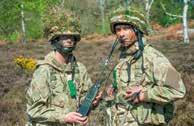
Power: Frequencies/waveforms:
Security:
Weight:
1W UHF & 121.5MHz
225MHz to 299.975MHz + 121.5MHz, 3,000 channels in 25kHz steps
Encrypted individual identification code assigned to each user; LPI/LPD less than 0.85kg

ASARS- and NATO-compatible radio featuring automatic activation, transmission of GPS location data and digital emergency messages, can be activated by another PRC-434. Endurance of 30 hours at 1:10 Tx/Rx ratio. www.armadainternational.com

Notes:

TACTICAL RADIOS LISTINGS
CNR-710MB multiband radio
CNR-710 Handheld
MTCR-7200 V/UHF
PRC-434G/CS survival
Get the
insiGht into the
latest
defence industry
Hook 3 combat survival radio

Power:
Frequencies/waveforms:
Security:
Weight:
Notes:
General Dynamics Mission Systems
1W – UHF; capable of 5W (FM), 200mW – VHF; capable of 2W (FM), 406 SARSAT 5.0W min, UHF SATCOM 5.0W ± 2dB
121.5MHz, 123.1MHz; 225MHz to 320MHz; capable of 100MHz to 512MHz; 406 SARSAT, Hook 2 & satcom
Hook 2 waveform is secure, 256bit AES encryption for satcom
0.680kg
New Hook family CSAR radio that is smaller, lighter and more powerefficient than its predecessors. Fully compatible with existing Hook 2 radios, Quickdraw2 interrogator, satcom base station.
General Dynamics Mission Systems
Power: Frequencies/waveforms:
Security:
Weight:
Notes:
Power: Frequencies/waveforms:
Security:
Weight: Notes:
Selectable up to 5W
225MHz to 450MHz, 1250MHz to 1390MHz, 1755MHz to 1850MHz, SRW and future waveforms
Programmable COMSEC and TRANSEC, Type 1, Type 2, not a Controlled Cryptogrphic Item (non-CCI)
0.767kg with battery, 0.43kg without
Small handheld networking radio providing secret or sensitive-but-unclassified communication for leaders or squad members in a single non-CCI device, designed to operate with AN/PRC-155. Compatible with Sidewinder vehicle mount.
General Dynamics Mission Systems

Power: Frequencies/waveforms:
Security:
Weight: Notes:
SR600 UHF Soldier Radio



Power:
Frequencies/waveforms:
Security:
Weight:
Notes:
Selectable up to 5W
225MHz to 450MHz, 1250MHz to 1390MHz, 1755MHz to 1850MHz, SRW and future waveforms
Programmable COMSEC and TRANSEC, Type 1, Type 2, not a Controlled Cryptogrphic Item (non-CCI)
0.767kg with battery, 0.43kg without
Small handheld networking radio providing secret or sensitive-but-unclassified communication for leaders or squad members in a single non-CCI device, designed to operate with AN/PRC-155. Compatible with Sidewinder vehicle mount.
up to 5W
142MHz to 175MHz VHF, 445MHz to 480 MHz UHF channel spacing 6.25kHz, 12.5kHz, 25kHz (user selectable), 4GFSK modulation end-to-end PKI encryption (256-bit AES)
78g
Small, light digital mesh-networking tactical radio designed to work with an iOS and Android smartphone apps. Designed to enable 100 percent off-grid comms using Android Team Awareness Kit, also supports custom apps. Offers text messaging, GPS team tracking, collaborative mapping, point sharing of targets, friendlies, rally points, medevac locations etc, emergency beacon. Pro X radios transmit critical data up to four miles point-to-point, and securely hop messages across six devices. Both offered with multi-device deployment kits.
Kongsberg Defence Systems
10mW to 1W
225MHz to 400MHz, to 5MHz bandwidth
Embedded AES256 encryption
0.7kg
Software-defined, IP-based SR600 connects all soldiers within a squad while offering full integration into the platoon/company network. Allows the squad leader full intra- and inter squad radio communication with a single radio. Also features high data capacity to share video over realistic combat distances.
MH300 Handheld Multi-Role Radio (MRR) Kongsberg Defence Systems

Power:
Frequencies/waveforms:
Security:
Weight: Notes:
15mW, 1W
30MHz to 87.975MHz, 2,320 channels
Built in encryption, up to level secret, comprehensive crypto and key management provided
1.055kg
Software configurable handheld MRR suited to CNR voice and advanced data networks. Features include tactical SMS with free-text or predefined messages (individual or group), “grab and run” from vehicle installation.
28 2022 Tactical Radios Supplement TACTICAL RADIOS LISTINGS
AN/PRC-112G Transceiver
Pro & Pro X goTenna goTenna
AN/PRC-154A Rifleman Radio
Power: Com ports: Immersion:
Weight: Notes:
Powered by the radio/comms device (3.6 to 36 V DC)
Three COM ports
20 meters for 2 hours (MIL-STD-810G)
152 grams
The INVISIO V60 II control unit is designed to be the ultimate communications hub. With 3 com ports and 4 PTT buttons, the control unit can connect into any type of communication device, such as multiple net radios, smart phones, a broad range of audio devices, headsets, and intercom systems for land, sea and air vehicles.


Power:
Hearing Protection: Immersion:
Weight:
Notes:
Powered by an INVISIO control unit
SNR 28 dB (EN351-2002), NNR 22 nB (ANSI S3.19)

10 meters for 1 hour (MIL-STD-810G)
347 grams
The INVISIO T7 is a submersible and lightweight hearing protection headset available in three interchangeable variants. The T7 is submersible to 10 meters and extremely rugged making it ideal for use in demanding environments. It is powered and controlled by an INVISIO control unit, making it easy to use and lightweight while featuring industry leading situational awareness.
Power:
Hearing Protection: Immersion:

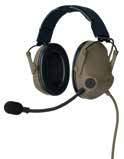
Weight:
Notes:
Powered by an INVISIO control unit
SNR 32 dB (EN352-2:2002), NNR 29 dB (ANSI S3.19)
2 meters for 2 hours (MIL-STD-810G)
70 grams
The INVISIO X5 is a dual sided in-ear hearing protection headset with state-of-the-art external microphones for natural hear-thru and six sizes of exchangeable foam plugs for market leading hearing protection and comfort. It is powered and controlled by an INVISIO control.
TACTICAL RADIOS LISTINGS
V60 II Control Unit INVISIO T7 Over-the-Ear Headset INVISIO X5 In-the-Ear Headset INVISIO
MP300
Power: Frequencies/waveforms:
Security:
Notes:
AN/PRC-150(C) HF Manpack Radio
Power: Frequencies/ waveforms:
Security:
Weight:
Notes:
AN/PRC-152A Wideband Networking Radio
Power: Frequencies/ waveforms:
Kongsberg Defence Systems
10mW, 0.5W, 5W, 50W/ MRR special waveform
30MHz to 87.975MHz, 2,320 channels
Built-in COMSEC; electronic protective measures including Narrow Band Direct Sequence Spread Spectrum (NBDS) in fixed-frequency operation, frequency hopping, multi-hop packet radio service with automatic routing, multipath integration.
Software upgradable man-pack for CNR and advanced data network services. Features: up to 19.2kbps data with forward error correction, voice, transparent and packet data, interference cancelling.
L3Harris Tactical Communications
1W, 5W, 20W PEP, -1/+2dB (1W, 5W, 10W FM)
1.6MHz to 60MHz/HF features: encrypted data, ALE, frequency hopping, vocoder, data link layer protocol, VHF features: vocoder, encrypted data US Type-1 and coalition encryption, enhanced frequency hopping
4.7kg without batteries
Falcon II family advanced HF-SSB/VHF-FM secure voice and data manpack radio. Provides up to 9,600bps (HF), and selectable ARQ modes reduce on-the-air transmission time and enhance secure data transmission. In addition to MILSTD-188-141B ALE, the AN/PRC-150(C) includes STANAG 4538 third generation HF Link Automation.
L3Harris Tactical Communications
user selectable 250mW to 5W, 10W satcom mode 30MHz to 520MHz and 762MHz to 870MHz. NB: AM/FM, VULOS, SINCGARS & HAVEQUICK I/II (standard), HPW, HPW IP, APCO P25 Phase 1 trunking, conventional and OTAR (optional). WB: ANW2C (standard), SRW (optional). UHF satcom: Mil-Std-188181B dedicated channel is standard, Mil-Std-188-182A, 183A DAMA, Mil-Std-188181C, 183B IW Phase 1, High Performance Waveform (HPW) & HPW IP, SATCOM TDMA capability waveform, all optional.
AN/PRC-117G Wideband Multi-band Multi-mission Radio

Security: Weight: Notes:
Power: Frequencies/ waveforms:
Security:
Weight: Notes:
Falcon III AN/PRC-158 Multi-Channel Manpack
Power:
Frequencies/waveforms:
Security: Weight: Notes:
RF-330-E-HH wideband networking handheld

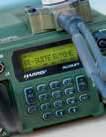

Power:
Frequencies/waveforms:
Security:
Weight: Notes:
Sierra II programmable crypto, secret or sensitive but unclassified
1.2kg max with GPS, battery and antenna Handheld networking SDR for simultaneous voice and data, including video.
L3Harris Tactical Communications
NB 10W, satcom 20W; WB 20W peak, 5W average 30 MHz to 2GHz. NB: AM/FM, VHF/UHF LOS, SINCGARS, Havequick I/II standard, SATURN, APCO P25 & P25 OTAR optional; WB: SRW, ANW2 C, ROVER III L-Band receive (optional)
Sierra II-based, Type 1 encryption for WB/NB NSA-certified top secret and below
3.7kg without battery, 5.44kg with Software defined tactical radio focused on wideband data, interoperability with fielded waveforms.

L3Harris Tactical Communications
Narrowband: 10W, SATCOM: 20W; Wideband: 20W peak, 10W average (max) 30MHz to 2.5GHz NB: VHF 30MHz to 225MHz, UHF 225MHz to 520MHz & 762MHz to 874 MHz. NB waveforms: AM/FM, VHF/UHF LOS, SINCGARS, Havequick, (SATURN, APCO P25 capable). SATCOM: Rx 243MHz to 270MHz, Tx 292MHz to 318MHz. MUOS: Rx 360MHz to 380MHz, Tx 300MHz to 320MHz. WB: 225MHz to 520MHz
UHF, 762MHz to 2.5GHz L-band. WB waveforms: SRW, ANW2C.
Sierra II-based, Type 1 (Suite A/B) NSA certified Top Secret and below.
5.76kg inc battery.
Multi-channel man-pack includes MUOS-ready hardware for SATCOM connectivity while on the move. NSA-certified for voice and data up to U.S. TOP SECRET with L3Harris Sierra II encryption, the man-pack is fully JTRS COMSEC and TRANSEC compliant.
L3Harris Tactical Communications
3.2W max, user selectable UHF: 225MHz to 450MHz, 99 channel presets (L-Band: 1250MHz to 1390MHz and 1755MHz to1850MHz, extension to 2.5GHz optional)/ ANW2C, others available.

Type 3 AES 256 for voice, video & data.
0.780kg with battery
Lightweight radio designed for operations in geographically challenging environments. Can serve as a ‘black’ relay for secure, encrypted video and data between multiple Type 1 tactical sets. Can be deployed a leave-behind device.
30 2022 Tactical Radios Supplement TACTICAL RADIOS LISTINGS
Personal Role Radio (PRR) Leonardo
Power: Frequencies/waveforms: Security: Notes:
50mW
2.4GHz direct sequence spread spectrum modulation
Encryption optional
Compact and lightweight PRR with a typical operating range of 500m in open terrain, and through three floors of a building, features wireless press to talk with up to 2m range, operates independently of any infrastructure, interfaces with combat net radios.
Power:
Frequencies/waveforms:
Security:
Notes:
100mW
2.4GHz direct sequence spread spectrum modulation
Encrypted
Typical operating range is 800m in open terrain, and through three floors of a building; wireless Press To Talk (PTT) with 2m range; features interchangeable switch pack, tailorable audio ancillaries; independent of infrastructure. Enhancements include extended range, more capable antenna, gooseneck antenna, data capabilities, rebroadcast, C2 base station, special purpose ancillaries.
Power: Frequencies/waveforms:
Security:
Weight: Notes:
5W (50W in vehicles)
30MHz to 512MHz V-UHF/ NB VuLOS V/U AM/FM (STANAG 4204/4205), IP MIL-STD-188-220C (datalink), SelfNET EASY II (EPM/ECCM), SelfNET Networking Soldier Broad band Waveform (WB MANET), SelfNET Narrowband Adaptive Waveform (NB MANET)
Embedded programmable COMSEC up to national restricted and TRANSEC, embedded AES 256 crypto engine, support for custom crypto algorithms. 0.63kg with standard battery
Handheld or body-worn radio for soldier and commander use at platoon or section level, offering simultaneous voice and data communications at the tactical edge, configurable for vehicle use.


Power: Frequencies/waveforms:
Security:
Weight:
Notes:
Up to 20W, or 50W with vehicle amplifier
VuLOS V/UHF AM/FM (NB), MIL-STD-188-220C (data link IP), SINCGARS, HQ I/II , SelfNET EASY II (EPM), DAMA (MIL-STD-181A, MIL-STD-182A, MILSTD-183, MIL-STD-184 (TACSAT), SelfNET Networking Soldier Broadband Waveform (WB MANET), SelfNET Narrow Band Adaptive WF (NB MANET)
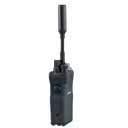
Embedded customisable COMSEC, TRANSEC under 8kg inc battery
Family of reconfigurable man-pack radios for dismounted and vehicular use, supporting wide-band IP voice and data, secure CNR voice and video.
Power:
Frequencies/waveforms:
Security:
Weight: Notes:
Frequencies/waveforms: Security:
Weight:
Notes:
Selectable 0.25W, 1W, 2W, 5W and up to 10W
Narrowband: 30MHz to 512 MHz, Wideband: 225MHz to 512 MHz, AM: 108MHz to 512MHz/ NB: TDMA Networking Waveform (TNW) 25K and 75K; WB: M-TNW, ANW2 C (optional) Quicklook 1A, 2, 3 and Quicklook-Wide ECCM, 1128bit & 256bit Harris proprietary Citadel AES 128 & 256, Customer Algorithm Modification encryption less than 1kg with battery
Intended for traditional CNR missions, ground-to-air and company and below voice and data comms. Optional 50W amplifier enables use in mid-tier tactical networks. Provides manpack performance in a handheld, interoperable with Falcon II and III sets.
Defence Information Systems Agency Enhanced Mobile Satellite Services. NIST certified AES 256 voice and data encryption (can be used by coalition troops).

0.510kg without antenna.
Using Distributed Tactical Communications System satcom service, operator can reach thousands of other RO tactical radios within a 100-250 mile range anywhere with sight of sky. Described as a global push-to-talk satcom tactical handheld radio.


2022 Tactical Radios Supplement 31 TACTICAL RADIOS LISTINGS
RO Tactical Radio
L3Harris Tactical Communications
RF-7850M-HH Multiband Networking Handheld
L3Harris Tactical Communications
Swave MB1 manpack/vehicle radio Leonardo
Leonardo
Enhanced Personal Role Radio (EZPRR)
Leonardo
SWave Enhanced Handheld (HH-E)
SINCGARS RT-1523 VHF Radio
Power: Frequencies/waveforms:
Security:
Weight: Notes:
SINCGARS RT-1702 VHF Combat Net Radio
Power: Frequencies/waveforms:
Security:
Weight: Notes:
Tactical Network Rover (TNR)
Notes:
L3Harris Tactical Communications
1mW, 100mW, 5W, 50W (with power amplifier)
30MHz to 87.975MHz/ SINCGARS
internal Encryption Module, CT/PT, frequency hopping
3.5kg with battery
Offered in vehicle and man-pack configurations. In the mobile role, the radio works with an embedded tactical data router, and as a man-pack it features a standard point-to-point-protocol interface. Both allow a C2 application to access the tactical internet.
L3Harris Tactical Communications


1mW (LO), 100mW (MED), 5W (HI), 50W (PA with RFPA power amplifier)
NB: STANAG 4204 compliant (SC); WB: SINCGARS (FH)
Country unique Pavilion SINCGARS
3.5kg including BB-2590 battery
Man-pack or vehicle-mount radio that provides situational awareness through real-time maps, location and IP data with an optional, embedded 12-channel GPS.
L3 Harris Communications Systems West
Handheld transceiver that provides a multi-megabit, bidirectional data link capability to dismounted combat troops. Combines video downlink receiver functionality with broadband IP networking capability. TNR uses the existing ROVER communications infrastructure for air-to-ground interoperability and ground-to-air networking within a Net-T network, supporting digitally aided close air support, ground force position sharing, chat and large file transfers.
Tactical Network Rover e (TNRe) video receiver
Frequencies/waveforms:
Security:
Notes:
L3 Harris Communications Systems West
Supports UHF, L-, S-, C- and Ku-Band operations/ capabilities include DDL, DVB-T, Tactical, BE-CDL, CDL, Legacy digital, 466ER, VNW and FM analog

NSA-approved Type 1 and AES encryption
Small-form-factor hand-held radio provides full bidirectional connectivity to vehicles or the dismounted user. Receives full-motion video and sensor data, enables secure digital video, chat, VoIP and other network-enabled applications. Fully interoperable with ROVER. Antenna can be connected directly to radio or remotely through cables.
CRE2-189, GCS RADIO TRANCEIVER AND ANTENNA Radionor

Power:
Frequencies/waveforms:
Security:
Weight:
Notes:
CRE2-179-UAV,
Power: Frequencies/waveforms:
Security:
Weight:
Notes:
19-55 VDC/250W
4.900 -5.900 GHz
COMSEC and TRANSEC provided by digital beam-forming and AES-256 encryption embedded in hardware
12,5 kg
Phased array wireless data-link. Maximum data capacity 15 Mbps. IP based. Long range, exceeding 200 km. Vertically mounted panel with radio transceiver and antennas ideal for vessels and semi-mobile installations. The unit is fully compliant with the very most demanding class of electromagnetic compatibility and immunity according to MIL-STD-461F. Water ingress protection is IP67 (Submergible).
Radionor
19-55 VDC/250W
4.900 -5.900 GHz
COMSEC and TRANSEC provided by digital beam-forming and AES-256 encryption embedded in hardware
2 kg
Phased array wireless data-link. Maximum data capacity 15 Mbps. IP based. Long range.Horizontally mounted panel with radio transceiver and antennas ideal for UAV applications.The antenna panel has the same properties as CRE2-179, but with significantly lower weight adapted for UAV applications. The unit is fully compliant with the very most demanding class of electromagnetic compatibility and immunity according to MIL-STD-461F. The product has also been tested to all relevant parts of environmental requirements according to DO-160G. Water ingress protection is IP67 (Submergible).


32 2022 Tactical Radios Supplement TACTICAL
RADIOS LISTINGS
UAV ๆRADIO TRANSCEIVER AND ANTENNA
TACTICAL RADIOS
CRE2-144-M2, HELMET MOUNTED RADIO Radionor




Power: Frequencies/waveforms:
Security:
Weight: Notes:
9-36 VDC
4.900 -5.900 GHz
COMSEC and TRANSEC provided by digital beam-forming and AES-256 encryption embedded in hardware
295g
C-band phased array tactical wireless radio. IP centric/ad hoc network operations. Compact radio transceiver and antennas ideal for portable or man-carried applications. The radio/antennas have very low weight and are to be mounted on top of a helmet. The radio has two Ethernet connections and military grade rugged for harsh environments with a special easy-to-clean connector for mud and dust. The unit is waterproof including full submerging in water (IP68). The unit also has built-in GPS and options for insertion of short range wireless interfaces to connect to user terminal equipment such as PCs, pads, and mobile terminals.
Power:
Frequencies/waveforms:
Security:
Weight: Notes:
Max 5W (FM, programmable), max 6W (PEP) 20MHz to 520MHz and 30MHz to 137MHz/ DV Reutech narrowband waveform providing secure voice transmission, 25kHz channels, digital voice transmission, 100 hops per second in frequency hopping mode, fixed frequency. Analog voice transmission at a fixed frequency in FM and AM, Radmor Serial Data (RSD) data transmission.

TRANSEC & COMSEC cryptographic protection, AES-256 voice protection
< 1kg
Handheld SDR radio, developed using a common hardware platform for all COMP@N family radios, on which there are a number of waveforms implemented. HO7 is designed for voice communication, including: tactical short-range VHF and UHF communication for land forces; tactical short-range communication VHF for air force; communication with civilian services.
Radmor
Power: Frequencies/waveforms:
Security:
Weight: Notes:
Programmable FM max 5W, programmable AM max 4 W-PEP, CPM (W2FH): 0.1W, 1W, 5W 20MHz to 520 MHz and 30MHz to 13MHz7W2FH (Waveform with Frequency Hopping) – narrowband EPM (Electronic Protective Measures) waveform that can operate in the frequency hopping mode or at fixed frequency, STANAG 4204 - fixed frequency VHF FM, STANAG 4205 - fixed frequency UHF FM/AM
TRANSEC & COMSEC cryptographic protection
< 1kg
Handheld SDR developed using a common hardware platform for all COMP@N family radios. W2FH waveform allows simultaneous transmission of voice and data, while the synchronization mechanism does not require GNSS.
Radmor
Power:
Frequencies/waveforms:
Security:
Weight: Notes:
Programmable FM, max 5W, programmable AM, max 4 W-PEP, CPM (BMS IP WF): 0.1W, 1W, 5W 20MHz to 520 MHz / 30MHz to 137MHz/ BMS IP WF – narrowband MANET waveform that can operate in frequency hopping mode or at fixed frequency, STANAG 4204 – working at a fixed frequency VHF FM, STANAG 4205 – working at a fixed frequency UHF FM/AM.
TRANSEC & COMSEC cryptographic protection
< 1kg
Handheld SDR developed using a common hardware platform for all COMP@N family radios. Has implemented several waveforms, which allow a smooth transition from classical systems to modern BMS. BMS IP WF allows integration with IP networks, simultaneous voice and data transmission.
Rafael Advanced Defense Systems
Power:
Frequencies/waveforms:
Security:
Weight:
Notes:
5W/20W (BNET-MPS), 50W per channel (BNET-V)
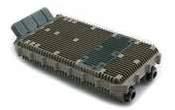
Narrowband waveform 30MHz-88MHz, 225-512MHz (108MHz-174MHz) optional. Wideband waveform 225MHz-512MHz (L-band/S-band optional). Can support additional waveforms.
Networking ECCM capabilities, frequency hopping spread spectrum techniques.
6kg (BNET-MPS), 13kg (BNET-V)
The BNET-MPS is the manpack member of the overall BNET family with the BNET-V being its vehicular counterpart.
Power:
Frequencies/waveforms:
Security:
Weight: Notes:
0.1W to 4W
225MHz to 2GHz/ Eight-hop relay, CPSM with DSSS, TDMA, CDMA and FDMA supports commercial Advanced Encryption Standard (AES) for Secure But Unclassified (SBU) transmission
0.76kg
Provides simultaneous voice, data and video, automatic position location reporting, giving commanders the ability to see the location of all people and assets at all times, even in GPS-denied environments.
2022 Tactical Radios Supplement 33
LISTINGS
Radmor
COMP@N
H07 VHF/UHF handheld
COMP@N H09
COMP@N H08
BNET-MPS/V
Microlight DH500 Raytheon
TACTICAL RADIOS LISTINGS


EPLRS-XF-I Raytheon
Power: Frequencies/waveforms:
Security: Weight: Notes:
EPLRS-XF-I
(lightweight)
Power: Frequencies/waveforms:
Security:
Weight:
Notes:
50W max
225MHz to 450MHz/ enhanced positioning, TCP/IP MANET
AES encryption
8kg
Man-pack vehicle and airborne EPLRS radio providing robust, on-the-move, high-speed, automated data exchange using a contention-free networking architecture.

Raytheon
10W to 20W 30MHz to 512MHz, 142 channel pre-sets/ SINCGARS, SATCOM, DAMA, HAVEQUICK I/II, AM, FM, FSK, B/SB/DESB/SOQ PSK embedded encryption engine, embedded COMSEC for voice and data
5.2kg
Provides lightweight, secure, network-capable, multi-band/multi-mission, anti-jam, voice/ imagery/ data communications capability in a single package.
TR3000 Reutech
Power:
Frequencies/waveforms:
Security:
Weight:
Notes:
150W
1.5MHz to 32MHz Secure Digital Voice 3G STANAG 4538 Packet Data
WBHF MIL-STD-188-110D (up to 240 kbps) Frequency Hopping AES256, optional fit user definable tamper proof INFOSEC, TRANSEC module
< 10kg
Direct RF sampling digital architecture
MTR1025 Manpack Reutech

Power: Frequencies/waveforms:
Security:
Notes:
30W
1.6MHz to 30MHz, HF User definable tamper proof INFOSEC, TRANSEC module
Features integrated texting from front panel, CNIS Link-ZA compliant data link, Bluetooth for peripherals, auto GPS position reporting, ALE to MILSTD-188-141A, APP A, data to MIL-STD-188-110A and STANAG 4285 local/ networked RC, built-in antenna tuning, Li-ion battery with gauge.
SOVERON® D – Streitkräftegemeinsame verbundfähige Funkgeräteausstattung SVFuA Rohde & Schwarz
Power:
Frequencies/waveforms:
modular
Security:
Certified for SCA 2.2.2, the SOVERON® D radio platform is prepared for porting future and legacy waveforms. It is accompanied by a high-performance waveform family, such as SOVERON® WAVE. SOVERON® D will also use the ESSOR high data rate waveform that was developed within the framework of the trans-European interoperability initiative for armed forces at the tactical level, an initiative the Federal Republic of Germany has joined. In addition, the NTN (National Tactical Network waveform)-family is fielded with SVFuA in the German Armed Forces. The SOVERON® D ‘software-defined-crypto’ platform allows a flexible lifecycle of encryption methods. Robustness against jamming attacks with TRANSEC fast frequency hopping measures. Support for ‘multi-level security’ MLS. Transmission of voice and data with confidentiality up to Ievel SECRET. SOVERON® D, known from the SVFuA development project of the German MoD features scalable security layer up to national and NATO SECRET.

Notes:
SOVERON®D is a highly modular SDR developed for the sovereign needs for tactical communication of the German Armed Forces. SOVERON® D manages communication networks through all echelons, with a special focus on joint and combined missions with multi-level security needs, supporting operations conducted by coalition forces. The system connects the vehicle IT infrastructure with the tactical command and control system.
34 2022 Tactical Radios Supplement
SOVERON® VR Rohde & Schwarz
Power: Frequencies/waveforms:
Security:
Notes:
All modes: 50 W; A3E carrier: 12.5 W.
The core of the SOVERON®VR vehicular radio is an SCA 2.2.2 radio platform that supports standardized, legacy and Rohde & Schwarz proprietary waveforms and makes it easy to port waveforms. In addition, it allows customized waveforms and cryptology to be implemented. Frequency range from 30 MHz to 512 MHz without gaps.
Strict red/black separation. Crypto ignition key support. Ad-hoc networking (MANET) capability. Frequency hopping (TRANSEC). AES encryption (COMSEC)
SOVERON® VR has been designed for use in vehicles and for integration into semi-stationary and stationary applications. Its ruggedized hardware meets applicable MIL-STD environmental and EMC requirements, enabling the radio’s use under extreme conditions such as in armored wheeled vehicles and tracked vehicles. Together with the SOVERON® HR handheld tactical radio, SOVERON® VR forms a seamless connection to peers and the higher echelons on the battlefield to provide a common operational picture.
SOVERON® HR Rohde & Schwarz
Power: Frequencies/waveforms: Security:
Weight Notes:
Badger HU Combat Net Multiband (HF/VHF/UHF)
Power:
Cheetah 3 VU Combat Net Multiband (VHF/UHF)



High: 5 W; Medium: 2 W; Low: 0.2 W
Frequency range from 30 MHz to 512 MHz without gaps
Ad-hoc networking (MANET) capability. Frequency hopping (TRANSEC). AES encryption (COMSEC)
≤ 1.2 kg (2.65 lb) [with Battery? Without?]
The SOVERON® HR is a multiband handheld radio system that supports up to two voice channels and IP data transmission in parallel. It has been designed for use by dismounted soldiers, leaders and specialists under harsh field conditions in an electromagnetically contested environment. Its ruggedized hardware surpasses MIL-STD environmental and EMC requirements. Together with the SOVERON® VR vehicular radio, the SOVERON® HR handheld tactical radio forms a seamless connection to peers and the higher echelons on the battlefield to provide a common operational picture.

Sat-Com Secure and Tactical Communications
1.6-512MHz FM, USB/LSB, AM, FSK, MSK
BPSK, QPSK, PSK, QAM, DSSS* C
OMSEC: Encrypted AES256 Digital Voice
OTP / AES128, 1-600 hops per second.
8-digit decimal Mission Key.
Ad hoc channel scan / ALE
TacTalk - Messaging, Chat, E-mail, File Transfer. TacTalk-plus - Messaging, Chat, E-mail, File Transfer plus Frontline Battlefield awareness
5.8kg (including Battery)
The Badger has been specifically designed to be rack or panel mounted, an extension kit facilitates mounting in standard 19” rack. Perfect for Naval or Mobile installations. COMSEC (SDV) and TRANSEC(FFH) Modes on Scanning or ALE . All HF/VHF/UHF Features are interoperable with the Satcom suite of radios.

Sat-Com Secure and Tactical Communications
10W
30-512MHz
USB/LSB, AM, FM, FSK, MSK, BPSK, QPSK, PSK, QAM, DSSS
Encrypted AES256 Digital Voice
OTP / AES128, 1-600 hops per seco
8-digit decimal Mission Key.
Ad hoc channel scan / ALE
TacTalk - Messaging, Chat, E-mail, File Transfer.
TacTalk-plus - Messaging, Chat, E-mail, File Transfer plus Frontline Battlefield awareness
2.98kg (including Battery)
COMSEC (SDV) and TRANSEC(FFH) Modes on Scanning or ALE . All VHF/UHF Features are interoperable with the Satcom suite of radios.
1-600 hops per second.
8-digit decimal Mission Key.
Ad hoc channel scan / ALE
TacTalk - Messaging, Chat, E-mail, File Transfer.
TacTalk-plus - Messaging, Chat, E-mail, File Transfer plus Frontline Battlefield awareness. Backpack, Mobile Racks, Base Racks, Custom Solutions
4.5kg (including Battery) COMSEC (SDV) and TRANSEC(FFH) Modes on Scanning or ALE . All HF/VHF/UHF Features are interoperable with the Satcom suite of radios.
2022 Tactical Radios Supplement 35
LISTINGS
TACTICAL RADIOS
Leopard HU Combat Net Multiband (HF/VHF/UHF) Sat-Com Secure and Tactical Communications 30W@(1.6-30MHz),18W@(30-88MHz),10W@(88-512MHz) 1.6-512MHz FM, USB/LSB, AM, FSK, MSK. BPSK, QPSK, PSK, QAM, DSSS* COMSEC: Encrypted AES256 Digital Voice OTP / AES128,
Frequencies/waveforms: Modulation: Advanced Modem: Security: Transec: Nets: Linking: Enhanced Features: Weight: Note: Power: Frequencies/waveforms: Modulation: Advanced Modem: Security: Transec: Nets: Linking: Enhanced Features: Weight: Note: Power: Frequencies/waveforms: Modulation: Advanced Modem: Security: Transec: Nets: Linking: Enhanced Features: Mounting: Weight: Note:
PEP @ (1.6-30MHz). 18W PEP @ (30-88MHz). 10W PEP @ (88-512MHz
30W
Power: Frequencies/waveforms:
Security:
Weight: Notes:
0.1, 0.5, 1.0, 3.0 and 5.0W user selectable (waveform dependent)
30MHz to 512MHz contiguous . Implemented and planned waveforms and modes include: AM/FM, Havequick I/II, MIL-STD-188-241-1/-2 (SINCGARS), MIL-STD-188-181B (56kbps), MIL-STD-188-181C, -182B, -183B (SATCOM IW), ANDVT, Project 25, Over The Air Cloning (OTAC), retransmission
Programmable encryption engine supports NSA crypto modernisation requirements, certified by NSA.
0.867kg with battery
An evolution of the combat- proven AN/PRC-148 MBITR, the JEM is a JTRSapproved production radio, is part of a complete communications system for mounted and dismounted operations.
Power: Frequencies/waveforms:
Security:
Weight: Notes:
5 W in all frequencies
30MHz to 512MHz , Soldier Radio Waveform (SRW) , MIL-STD-188-241-1/-2 (SINCGARS - Standard/ FH2 EOM), MIL-STD-188-181C, -182B, -183B (SATCOM IW) , HAVEQUICK I and II, ANDVT (LPC-10, MELP), AM/FM, Project 25. Programmable encryption engine supports NSA crypto modernisation requirements, certified by NSA.

1.225kg
Combines AN/PRC-148 and AN/PRC-154 wideband tactical handheld radio capabilities to integrate dismounts into the wideband tactical IP and voice network via the SRW, simultaneously connecting with older nets via narrowband.

Power: Frequencies/waveforms:
Security:
Weight: Notes:
0.1W to 5.0W
30MHz to 512 MHz contiguous , Havequick II frequency hopping ECCM waveform, country-specific ECCM waveforms
Type 3 DES (optional), 256-bit AES (optional)
0.867kg
Non-Type 1 version (without NSA approved cryptographic algorithms) of the AN/PRC-148 compatible with all MBITR family products and available to US, allied and coalition forces.
Thales
Power:
Frequencies/waveforms:
Security:
Weight:
Notes:
User selectable up to 5W 225MHz to 450 MHz (UHF band), 1,250MHz to 1,390MHz and 1,750MHz to 1,850MHz (L-band); supports SRW

Programmable COMSEC and TRANSEC NSA certified for Type 1 secret and below, non-CCI.
0.771kg with battery
Low-cost, body-worn radio that transmits voice and data simultaneously using the SRW, bringing secure secret and below squad-level communications to the soldier at the tactical edge, enables situational awareness and blue force tracking.
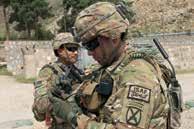
Thales
Power:
Frequencies/waveforms:
Security:
Weight:
Notes:
user selectable up to 5W UHF band 225MHz to 450MHz, L-Band 1250MHz to 1390 MHz, 1750MHz to 1850 MHz/ Soldier Radio Waveform (SRW) embedded encryption, COMSEC, TRANSEC

0.771kg with battery
Increased RF range, battery life, and added visual HMI display built on the successful and field proven AN/PRC-154A Program of Record Rifleman Radio
Thales
Power:
Frequencies/waveforms:
Security:
Weight:
Notes:
selectable up to 5W or 20W boosted mode in vehicle configuration
30MHz to 108MHz
Secured voice and data 16kbps digital encryption, high EPM protection including frequency hopping, free channel search and mixed mode
5.9kg with battery
Interoperable with Jaguar radios. Battery life: 32 hours with rechargeable LiIon battery pack. Advanced CNR services including group selective call, alert, authentication, passive late entry, over-the-air rekeying

36 2022 Tactical Radios Supplement TACTICAL
S
RADIOS LISTING
AN/PRC-6809 Multi-Band Inter/intra Team Radio
Thales
MBITR/JEM
AN/PRC-148B MBITR2
AN/PRC-148
Thales
Thales
AN/PRC-154B Rifleman Radio
AN/PRC-154A Rifleman Radio
BCC 67 Panther VHF Manpack Radio
F@stnet Twin Thales
Frequencies/waveforms:
Notes:
VHF and UHF
F@stnet Twin keeps infantry leader in touch with soldiers through the embedded UHF soldier channel while being continuously in touch with the commanding level thanks to the embedded VHF channel. Designed for interoperability with legacy waveforms; handles simultaneous voice and data.
soldier radio Thales

Frequencies/waveforms:
Security:
Weight:
Notes:
865MHz to 880MHz, 100 talk groups over 50 channels with up to 50 users per channel/ programmable encryption with red/black architecture
250 including battery
“Unique” waveform ensures communication is maintained across urban, wooded and mountainous terrain. In open terrain SquadNet gives a 2.5km range point-to-point, extending to 6km with automatic network relaying, maintaining secure comms over IP networks with an Android app
BATS-D AN/PRC-161 Handheld Link 16 Radio ViaSat



Power:
Frequencies/waveforms:
Weight:
Notes:
8W or 8mW transmit power
Link 16 Voice/Data waveform enables 26.8kbps through 1102 kbps TADIL J coded, free text variable format for enhanced throughput 1kg including battery
Radio fuses air and ground Situational Awareness (SA) in a handheld package designed for use at the tactical edge. Designed to be used vestworn, handheld, or mounted by special operations and expeditionary forces, including Joint Terminal Attack Controllers (JTACs), Forward Air Controllers (FACs), Tactical Air Control Party (TACPs), as well as size, weight, and power constrained platforms.











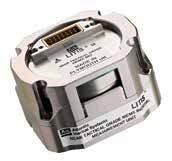 © 2022 Collins Aerospace
© 2022 Collins Aerospace
 By Andrew White
By Andrew White











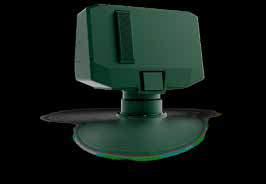







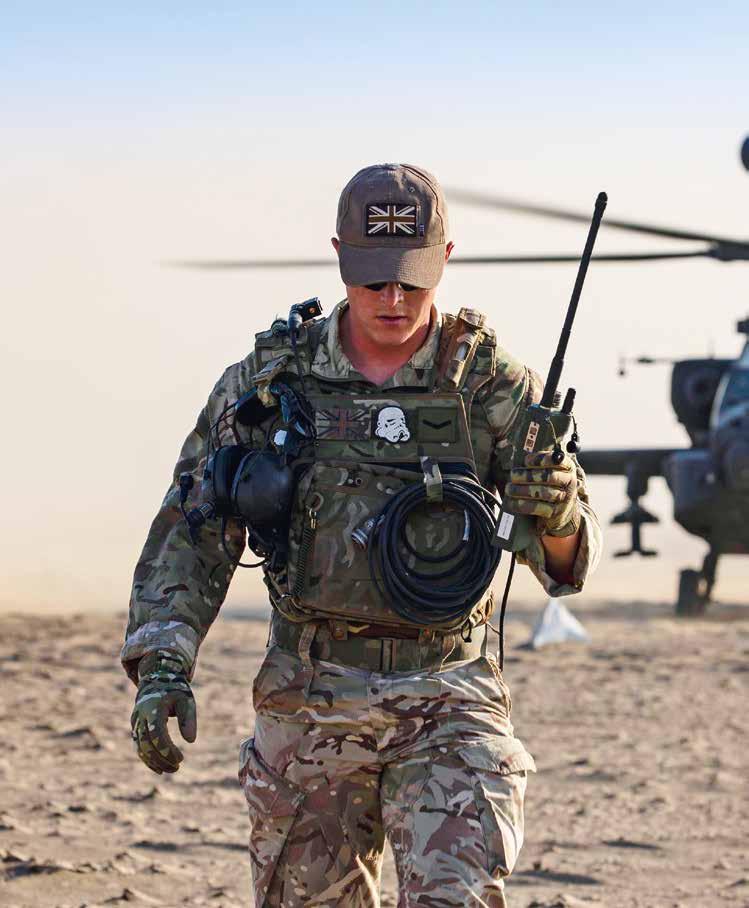


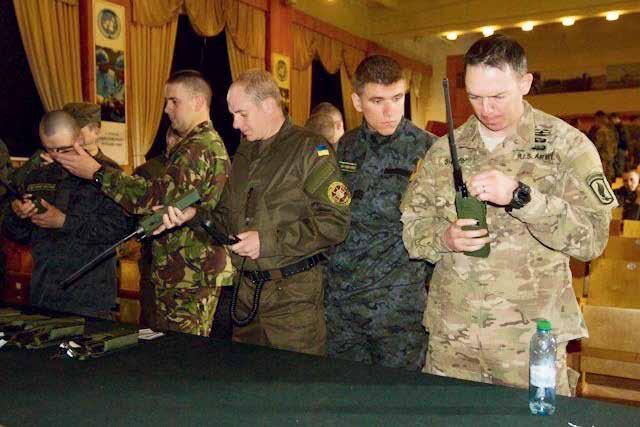 by Thomas Withington
by Thomas Withington
